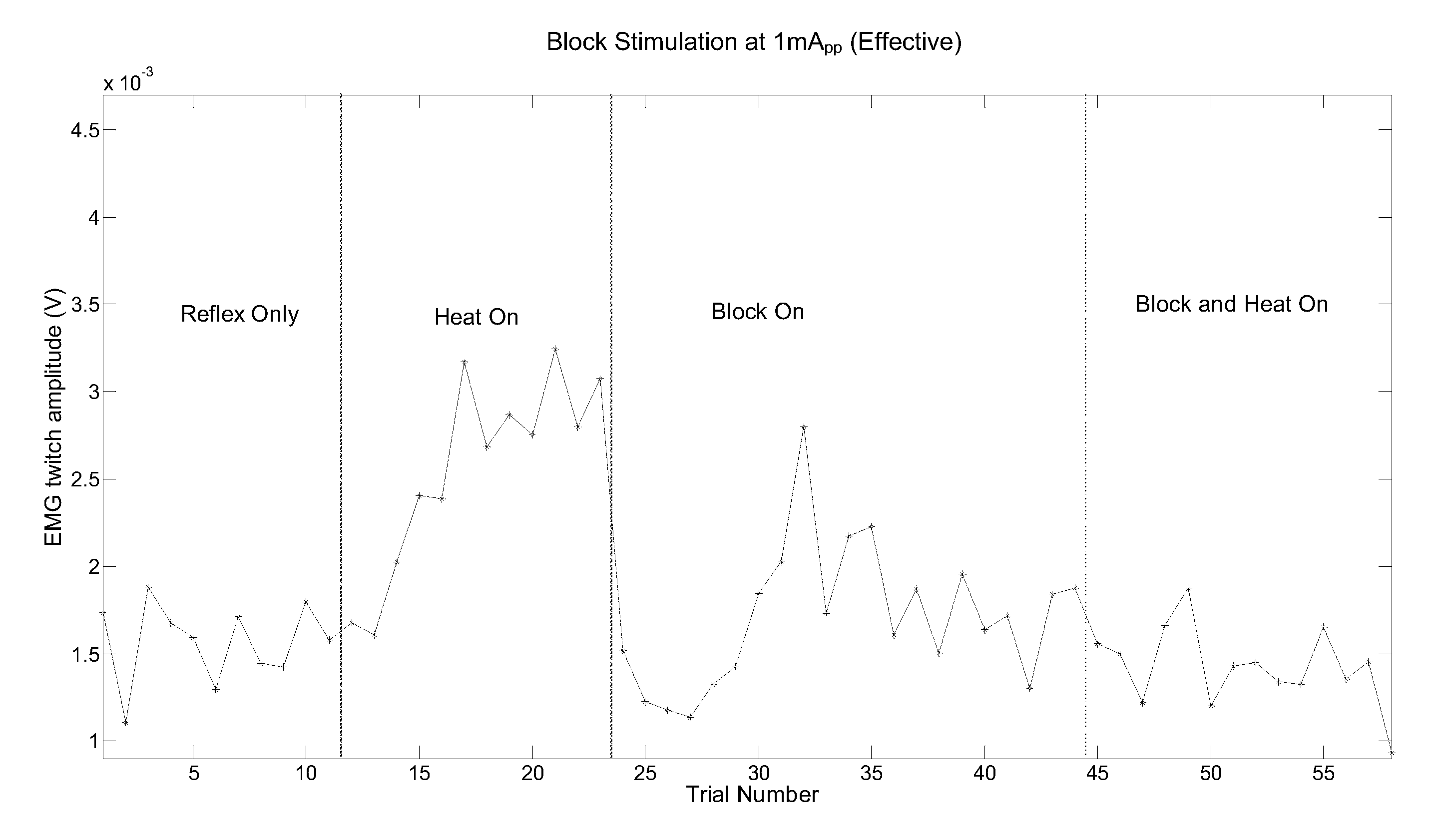Method to treat pain through electrical stimulation of nerves
a nerve stimulation and nerve technology, applied in the field of pain treatment, can solve the problems of slow signal-transmission rate, long and intensive trial and error procedure, and many cases that are not well controlled on any of these medications
- Summary
- Abstract
- Description
- Claims
- Application Information
AI Technical Summary
Benefits of technology
Problems solved by technology
Method used
Image
Examples
example 1
[0046]The Sural-Gastrocnemius reflex in rabbits can be elicited by stimulating the sural nerve and measured as an EMG twitch in the Gastrocnemius muscle. This reflex is amplified by pain signals (e.g. heat applied to the skin on the heel), as indicated by a large increase in the amplitude of the reflex. A series of experiments were conducted in a rabbit model to measure the effectiveness of treating pain through application of a non-pulsed, low-frequency electrical current across the sural nerve in a direction transverse to the nerve longitudinal axis. In a first set of experiments, the efficacy of this treatment was measured utilizing the application of heat to generate the pain signal. A number of trials were conducted under a series of four conditions: electrical stimulation to elicit a motor reflex response; the application of that stimulation combined with application of heat to the skin of the rabbit heal; application of a non-pulsed, 130 Hz sinusoidal current transverse to th...
example 2
[0050]A second set of experiments was also conducted similar to those in Example 1 above, except this time capsaicin applied to the rabbit heel was used to induce the pain signals in the sural nerve. This set of experiments yielded remarkably similar results (data shown in FIG. 5). As in Example 1, the transversely-applied 130 Hz non-pulsed current essentially blocked the pain signal resulting from capsaicin application at the rabbit heel. These results confirm that the pain signals are indeed carried by C-fibers, and that application of a transverse, non-pulsed, low-frequency current as herein disclosed is an effective treatment to inhibit (and in the experiments of Examples 1 and 2, essentially block) the transmission of pain signals through those fibers.
example 3
[0052]A further set of experiments were conducted to demonstrate the efficacy of the disclosed methods to attenuate pain signals in the sural nerve. FIGS. 8 and 9 show respective plots of EMG twitch-response data based on the same series of four conditions discussed above in Example 1. The differences from Example 1 were that the currents were applied longitudinally along the nerve axis as opposed to transversely, and in FIG. 8 the current was a 400 μA current while in FIG. 9 it was a 1 mA (1000 μA) current. Otherwise, the conditions of these experiments were the same as in Example 1.
[0053]As seen when comparing FIGS. 8 and 9, the 400 μA current was too low a magnitude to inhibit the transmission of pain signals through the C-fibers of the sural nerve. In fact, in at least some trials the pain signal seems to have been intensified compared to just “Reflex+Heat” alone. Conversely, when the 1 mA current was used the EMG twitch signal reflected essentially the baseline condition, indic...
PUM
 Login to View More
Login to View More Abstract
Description
Claims
Application Information
 Login to View More
Login to View More - R&D
- Intellectual Property
- Life Sciences
- Materials
- Tech Scout
- Unparalleled Data Quality
- Higher Quality Content
- 60% Fewer Hallucinations
Browse by: Latest US Patents, China's latest patents, Technical Efficacy Thesaurus, Application Domain, Technology Topic, Popular Technical Reports.
© 2025 PatSnap. All rights reserved.Legal|Privacy policy|Modern Slavery Act Transparency Statement|Sitemap|About US| Contact US: help@patsnap.com



